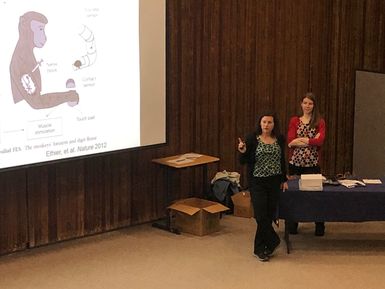Connecting Humans with Machines

As part of the 6th USA Science and Engineering Festival, the GISW held a so-called Nifty Fifty Event on Wednesday, February the 12th. Students of grades 9 to 12 were honored to have Dr. Alison Cernich, a neuropsychologist and the Deputy Director of the Eunice Kennedy Shriver National Institute of Child Health and Human Development as a guest lecturer.
Prior to assuming this important position last September, Dr. Cernich was the Director of the National Center for Medical Rehabilitation Research where she led the development and revision of the National Institutes of Health’s Research Plan on Rehabilitation.
Dr. Cernich began her presentation with an insight into the history of prosthetics which have existed since the era of Ancient Egypt (around 3000 years ago). Also, due in large part to our war-driven history - especially the two World Wars, science has made great leaps in compensating for the increased need of prosthesis. Nowadays, prosthetics are so advanced that they can be easily mistaken for actual limbs.
In general, there are two types of prosthetics: Body powered and electrical powered. Body powered prosthetics have been around longer, because of their simple composition. Their function is to replace a missing body part. However, controlling a body powered prosthetic has proven to be very difficult for the user.
That is why scientists have developed powered prosthetics – also known as myoelectric prosthetics which function by registering electrical impulses, also known as action potentials, which are the carriers of information across the human nervous system. To operate these electrical prosthetics, one must connect the prosthetic with the nervous system via the muscles of the patient. A microprocessor inside the prosthetic can then measure the electrical impulses sent by neurons, or nerve cells, to the "nonexistent muscles" and calibrate the prosthetic's response. Electrical prosthetics represent a huge scientific advance for mankind, because they allow us to almost fully replace the functionality of lost limbs.
Another approach of modern technological research, as described in the fascinating presentation by Dr. Cernich and Ms. Jackson, is to use robots steered by the mind. Mind reading robots function by receiving signals through sensors attached to the surface of the brain. The registered brain signals then are evaluated by a computer which in turn commands the robot to perform a certain task. The robot is intended to act as an extension of the user’s body and mind, which allows the user to perform very precise robotic movements.
At the end of the presentation Ms. Jennifer Jackson demonstrated the concepts with two small experiments that showed us how powered prosthetics work. First, she connected herself to a small robot through precise placement of sensors on her arm. Next, she contracted and relaxed her arm muscles, which resulted in the robot mimicking her movements accurately. Then Ms. Jackson linked herself to Dr. Cernich by placing sensors on both their arms. By contracting her own muscles, Dr. Cernich was able to contract the relaxed muscles of Ms. Jackson’s arm. The experiment was truly "nerve racking!" The entire presentation was remarkably informative and stimulating.
Following the lecture, the members of the Neuroscience Club of our school invited Dr. Cernich and Ms. Jackson to a brunch with our principal Ms. Palenzatis where interesting questions where further discussed.
Lea K. (12. Klasse)











